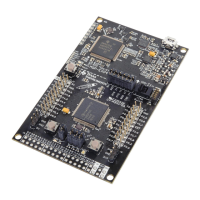Clocking
Additional Clock Features
There are a number of additional clock features that are summarized for our three example
devices in the following table
Additional Clock Features
Clock Feature
F5529 (UCS) F5969 (CS)
Available
Clock
Sources
MCLK
XT2, DCOCLK,
DCOCLKDIV
VLO, LFXT, LFMODCLK,
HFXT, MODCLK, DCOCLK
ACLK VLO, LFXT1 VLO, LFXT, LFMODCLK
Clock
Defaults
(at PUC Reset)
MCLK
DC0
(1.1MHz)
DCOCLKDIV
(1MHz)
DCO
(1MHz)
ACLK LFXT1
XT1CLK
(32KHz)
LFXT
ACLK = VLO
S/MCLK = DCO
LF XT1 = REFO
HFXT=MODCLK (5MHz)
DCO Calibration
FLL (Run-time) Factory Trimmed
Password Needed
(To change clock settings)
No No Yes
Clock Request
(Periph can force clk on)
WDT+ only Yes Yes
There’s quite a bit of information on this table. We’ll summarize the features row-by-row.
Available Clock Sources: The various clock oscillator sources were described earlier in this
chapter. This table shows which clock sources can be used for MCLK, SMCLK, and ACLK. You
might notice that, as we described earlier, the UCS peripheral (found on the ‘F5529) allows any
source to be used with any of the three clocks.
Clock Defaults: What happens if you do not configure the clock peripheral? As you might
expect, at (PUC) reset the three internal clocks default to a specific clock source and rate. These
are shown in the table.
External Clock Failsafe: What happens if the external crystal breaks or falls off your board?
The MSP430 clocks will default to an internal clock. While this may not be the rate/precision you
were expecting to run at, it’s better than having the system fail outright. There are clock fault
events that indicate if the external clock is not working correctly. (Note: it is expected that the
clock will be in a ‘fault’ state while the crystal is initializing.)
DCO Calibration: As we mentioned earlier – and will discuss in more detail later – different
generations of the MSP430 use different methods for calibrating the DCO. The first generation
forced you to do this in software; later generations use hardware or pre-calibrated constants.
Password: The latest generation of the MSP430 devices requires a password to modify the
clock configuration. The purpose of this is to prevent a software error from accidentally changing
the settings.
4 - 18 MSP430 Workshop - MSP430 Clocks & Initialization

